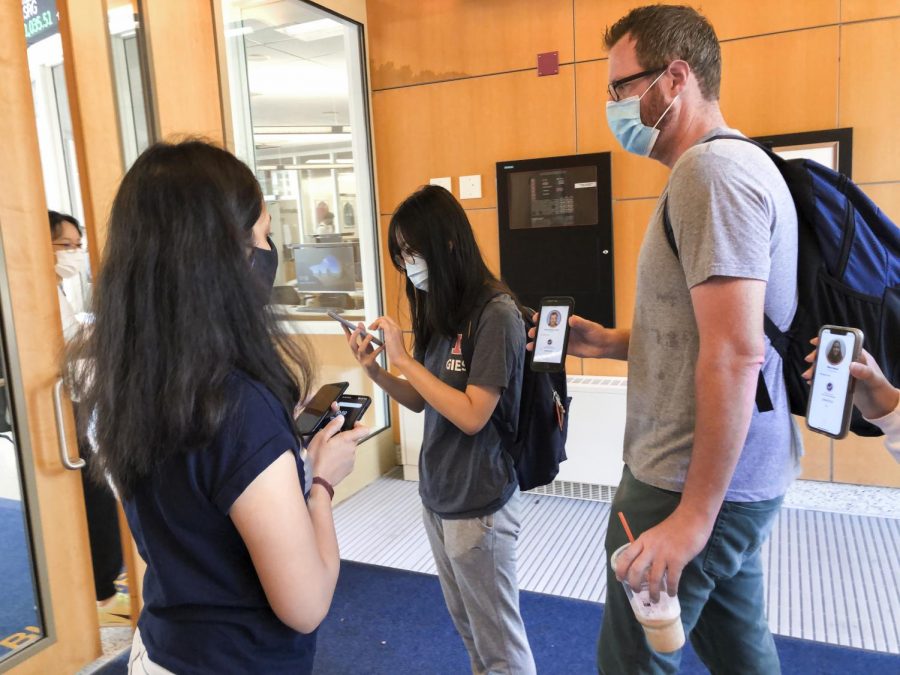UI officials retire Safer Illinois due to lack of resources, students express concerns
A University Wellness Associate checks people’s Illinois Safer app at the Gies College of Business on Sept. 14. With the app now transitioning to the Illinois app, students share their concerns.
Feb 7, 2022
Since shifting COVID-19 safety features from the Safer Illinois app to the Illinois app, some students have been frustrated with the change. But University officials said the decision was necessary to conserve human and financial resources.
“We’re kind of reconfiguring resources and the support necessary to keep our campus healthy from both a financial standpoint and from the standpoint of not continuing to stress out our (staff),” said Bill Sullivan, head of the team that developed Safer Illinois and the Illinois app.
According to the Illinois app website, the change was meant to keep necessary features like the building access screen while scaling back management of two separate apps. The COVID-19 boarding pass, an alternative to using a phone app, is still available for use.
Sullivan said he and his team had many discussions with various campus groups, including University Technology Services, academic deans and data privacy experts to make this decision.
His team was grateful to be a part of the efforts to create Safer Illinois, Sullivan said.
Get The Daily Illini in your inbox!
“But boy, it’s taken a toll, ” he said. “People are fried, they’re burned out. And the financial strain has been considerable.”
For students, the main complaint was that COVID-19 test results are no longer as easily accessible in the Illinois app like it was in Safer Illinois.
Gally Huang, junior in Engineering, said the current feature that includes a link to the McKinley login page isn’t user-friendly. He also said he’s experienced issues pulling up the building access screen.
“You can use the COVID boarding pass, I guess, but then like, what’s the point of the Illinois app then?” Huang said. “Like the point of this app is that I want to use it as best as I can when I’m trying to go to a class or exam.”
Due to app store requirements set by Apple and Google, Sullivan said features like test results couldn’t be easily showcased. Only COVID-19 apps, like the now-retired Safer Illinois app, could display certain health information. The Illinois app, classified as general use, cannot.
“We’re kind of under the thumb of Apple and Google in terms of not being able to deliver the functionality that we used to be able to deliver when we had the two apps,” Sullivan said.
When it comes to health data, Sullivan said Safer Illinois used to be connected directly with McKinley. Data was encrypted at multiple points in the process of reaching users’ phones.
Now, the data is sent to University Technology Services. A system performs logic tests based on parameters like vaccination status or testing compliance, then sends Sullivan’s team either “granted” or “denied”.
The Illinois app doesn’t involve any transferring of health data, nor do the app’s managers know why one’s building access is granted or denied, according to a spokesperson for University Technology Services.
In an email, University Technology Services confirmed that no health data is being transferred to the Illinois app.
“The biggest change is that the building access status feature in the Illinois app is less complicated than the one we had in Safer Illinois,” the email stated.
The Tech Services Help Desk said they’ve gotten a few questions about the change from the Safer Illinois app to Illinois app, but overall the transition has been received well.
Huang, who said he experiences problems with the Illinois app’s COVID-19 features, hopes the bugs in the app will be fixed soon.
He said he recognizes the importance of apps like these when it comes to public health.
“I think it’s really important to gather data and showcase it,” Huang said.
Sullivan said this process of managing different apps and working with health data has taught his team a lot about user privacy standards.
“We didn’t have any leaks or data breaches,” he said. “We set very high standards and our team was able to deliver on that. I feel like that’s really good news for us because it’s given us deep experience in the kinds of things that are critical for protecting privacy.”
As they work to improve on the Illinois app and develop new features, Sullivan said his team will continue to prioritize user privacy. This includes frequently updating the app’s mobile privacy statement, which he considers a “live document.”
“We understand that it’s not the best user experience, especially compared to the ease and simplicity of Safer Illinois,” he said. “But we’ve done this because in the larger scheme of things, we’re just trying to take care of everybody and the budget. And at the same time, serve people as best we can.”






